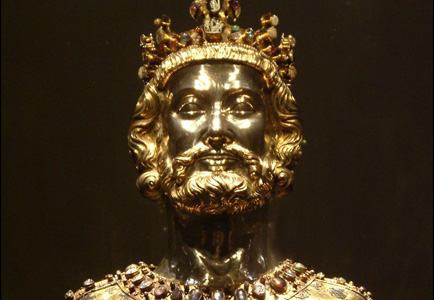
Charlemagne lived on
Charlemagne died on 28 January 814 in his palace in Aachen. It was not long before the mythification of his personage began, stylising Charlemagne as the ideal model of a ruler. Noble families claimed to be descended from him. The German, French and Bohemian kings followed his tradition. In their coronation ceremonies, places and objects from Charlemagne's life played an important symbolic role.
The memory of Charlemagne also lived on in courtly poetry and popular legends. One of them is the Chanson de Roland, which spread from medieval France through Germany and far into Eastern Europe. It depicts Charlemagne as the prototype of a crusader who conquers the Saracens in a dramatic battle after his nephew Roland has been insidiously betrayed. The story is pure fiction, but it has had a lasting effect on Charlemagne's image.
An artistic impression of Charlemagne's transformation into the timeless ideal of a ruler is also given by the Bust of Charlemagne in Aachen, dating from the 14th century. It unites symbols of the Holy Roman Empire and of the French kings. Inside it is a piece of Charlemagne's skull.
Bust of Charlemagne, circa 1349
Cathedral Treasury, Aachen


